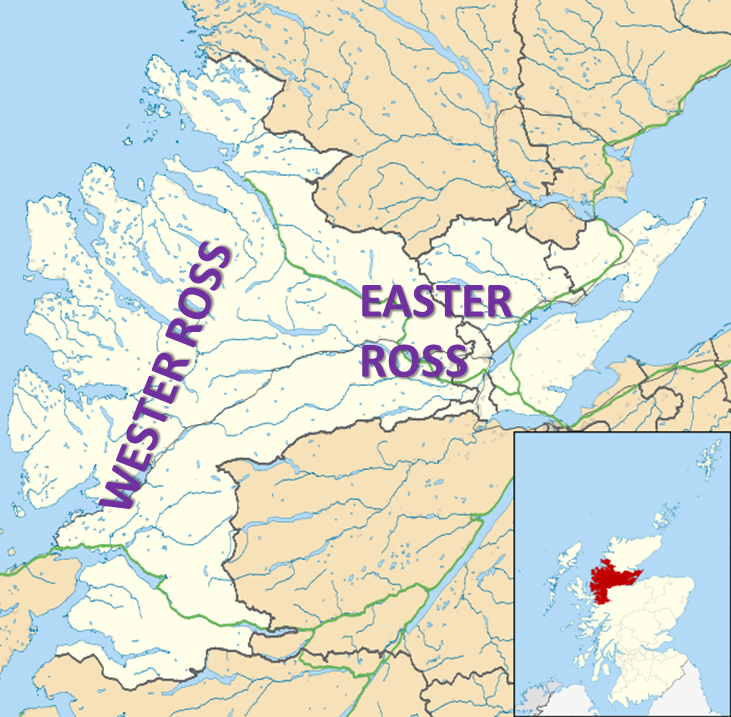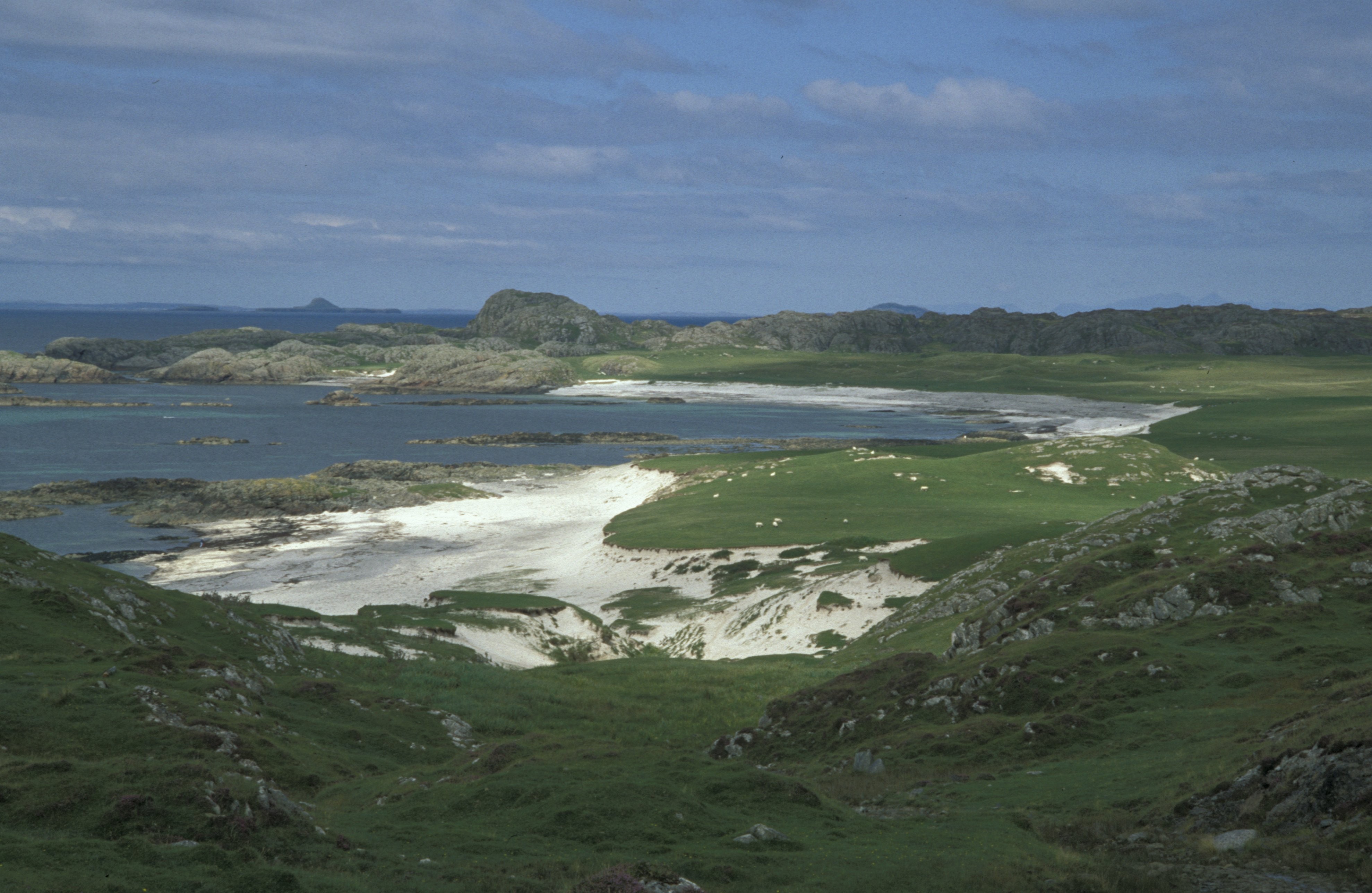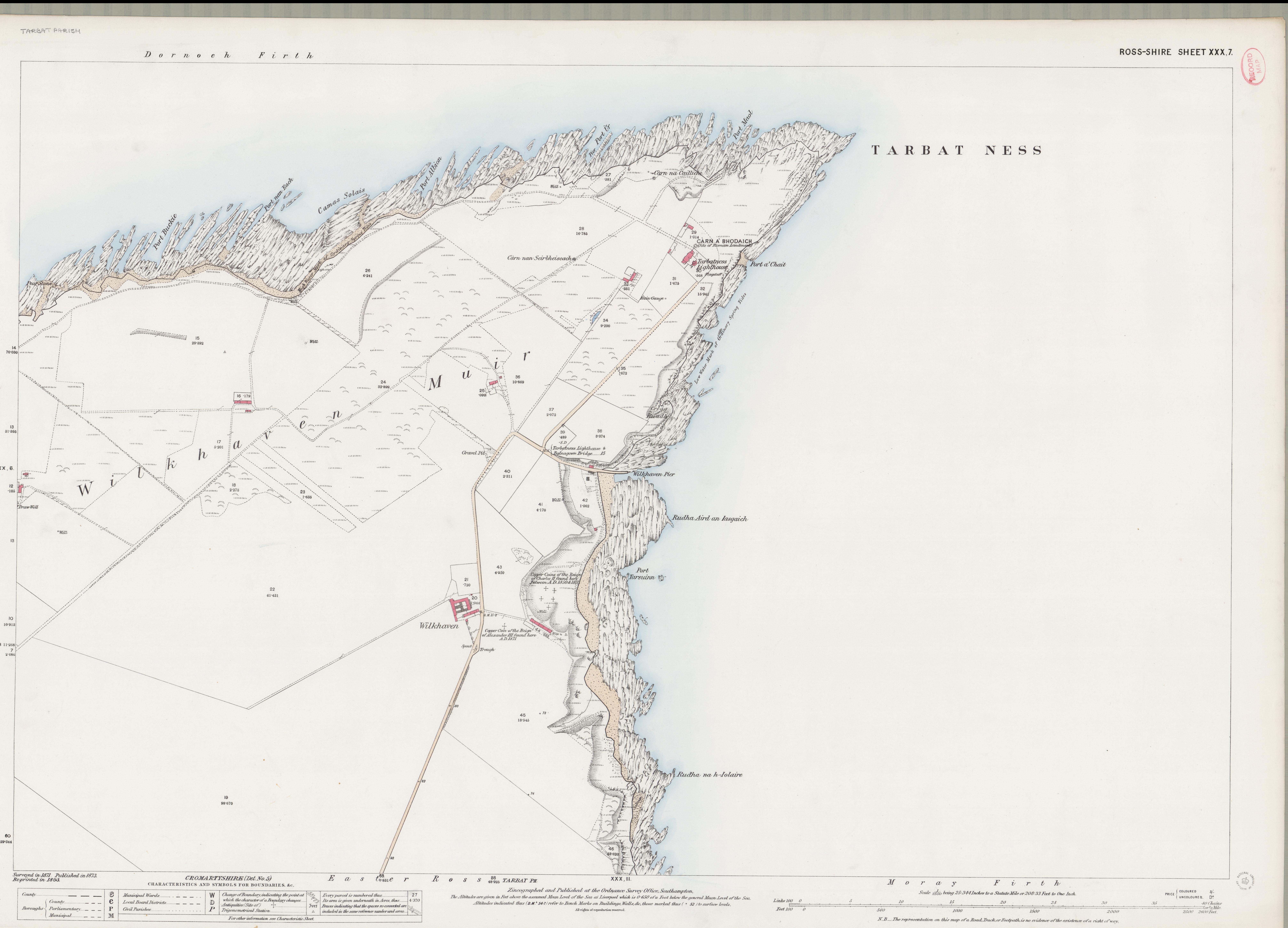|
Portmahomack Sculpture Fragments
The Portmahomack sculpture fragments are the slabs and stone fragments which have been discovered at the Easter Ross settlement of Portmahomack (Tarbat), Scotland. There are around 200 of these fragments, each the size of a handspan or larger, making Portmahomack one of the major centres of rediscovered Pictish art. Nineteen pieces were found in and around the churchyard before 1994, and the remainder were found during formal archaeological investigations by the University of York between 1994 and 2007 Tarbat Discovery Programme. The excavation director, Martin Carver has proposed that the majority of the carved pieces originated in four monumental crosses or cross-slabs of exceptional size and elaboration, placed around the site of St Colman's Church. One of these (TR1) carried four Pictish symbols, a second (TR2) had snake-headed interlace. A third (TR10, 20), features images of a complex beast and a row of apostles carrying books. This same stone originally carried along on ... [...More Info...] [...Related Items...] OR: [Wikipedia] [Google] [Baidu] |
Easter Ross
Easter Ross ( gd, Ros an Ear) is a loosely defined area in the east of Ross, Highland, Scotland. The name is used in the constituency name Caithness, Sutherland and Easter Ross, which is the name of both a British House of Commons constituency and a Scottish Parliament constituency. The two constituencies have however different boundaries. Settlements Places in Easter Ross include: * Alness * Dingwall (included in some contexts in the term ''Easter Ross'', though in some contexts it refers to the area to the north-east of Dingwall) * Evanton * Invergordon * Kildary * Milntown of Tarbat (Milton) * Portmahomack * The Seaboard villages: ** Balintore ** Hilton of Cadboll ** Shandwick * Tain Tain ( Gaelic: ''Baile Dhubhthaich'') is a royal burgh and parish in the County of Ross, in the Highlands of Scotland. Etymology The name derives from the nearby River Tain, the name of which comes from an Indo-European root meaning 'flow'. The ... Easter Ross is well known ... [...More Info...] [...Related Items...] OR: [Wikipedia] [Google] [Baidu] |
Early Christian
Early Christianity (up to the First Council of Nicaea in 325) spread from the Levant, across the Roman Empire, and beyond. Originally, this progression was closely connected to already established Jewish centers in the Holy Land and the Jewish diaspora. The first followers of Christianity were Jews or proselytes, commonly referred to as Jewish Christians and God-fearers. The Apostolic sees claim to have been founded by one or more of the apostles of Jesus, who are said to have dispersed from Jerusalem sometime after the crucifixion of Jesus, c. 26–36, perhaps following the Great Commission. Early Christians gathered in small private homes, known as house churches, but a city's whole Christian community would also be called a church – the Greek noun ἐκκλησία (''ekklesia'') literally means assembly, gathering, or congregation but is translated as church in most English translations of the New Testament. Many early Christians were merchants and others who had pr ... [...More Info...] [...Related Items...] OR: [Wikipedia] [Google] [Baidu] |
Pictish Stones
A Pictish stone is a type of monumental stele, generally carved or incised with symbols or designs. A few have ogham inscriptions. Located in Scotland, mostly north of the Clyde-Forth line and on the Eastern side of the country, these stones are the most visible remaining evidence of the Picts and are thought to date from the 6th to 9th century, a period during which the Picts became Christianized. The earlier stones have no parallels from the rest of the British Isles, but the later forms are variations within a wider Insular tradition of monumental stones such as high crosses. About 350 objects classified as Pictish stones have survived, the earlier examples of which holding by far the greatest number of surviving examples of the mysterious symbols, which have long intrigued scholars. [...More Info...] [...Related Items...] OR: [Wikipedia] [Google] [Baidu] |
Nigg, Highland
Nigg (from the gd, An Neag meaning "the notch", referring to a feature of the hills above the parish church) is a village and parish in Easter Ross, administered by the Highland Council. It lies on the north shore of the entrance to the Cromarty Firth. Nigg Old Church The present parish church is an 18th-century building on an early Christian site dating back to at least the 8th century. The Nigg Stone, one of the most elaborate stone monuments of early medieval western Europe, is preserved in a room at the west end of the church. This late 8th century Pictish cross-slab formerly stood in the churchyard, but was moved indoors for preservation in recent years. The nearby manse is one of the oldest to survive in Scotland, dating back to the first half of the 17th century. It is now privately owned and no longer used as the parish minister's residence. Nigg Old has its odd and curious features. In the churchyard is the Cholera Stone, dating from the cholera epidemic of 183 ... [...More Info...] [...Related Items...] OR: [Wikipedia] [Google] [Baidu] |
Shandwick
Shandwick ( gd, Seannduaig), a village near Tain in Easter Ross, and is in the Scottish council area of Highland, Scotland. Hilton Hilton or Hylton may refer to: Companies * Hilton Worldwide Holdings, Inc., a global hospitality company based in the United States that owns several hotel chains and subsidiary companies containing the Hilton name ** Hilton Hotels & Resorts, fla ..., Balintore, and Shandwick are known collectively as the Seaboard Villages. It is well known because of the nearby Clach a' Charridh or Shandwick Stone, a Class II Pictish stone. External linksHistory Website'' - online archive of the social history of the Seaboard Villages; Hilton, Balintore, and Shandwick * Populated places i ... [...More Info...] [...Related Items...] OR: [Wikipedia] [Google] [Baidu] |
Hilton Of Cadboll
Hilton of Cadboll, or simply Hilton, ( gd, Baile a' Chnuic) is a village about southeast of Tain in Easter Ross, in the Scottish Scottish usually refers to something of, from, or related to Scotland, including: *Scottish Gaelic, a Celtic Goidelic language of the Indo-European language family native to Scotland *Scottish English *Scottish national identity, the Scottish ide ... council area of Highland. It is famous for the Hilton of Cadboll Stone. Hilton of Cadboll, Balintore, and Shandwick are known collectively as the Seaboard Villages. References External linksHistory Website'' - online archive of the social history of the Seaboard Villages; Hilton, Balintore, and Shandwick * Populated places in Ross and Cromarty {{Highland-geo-stub ... [...More Info...] [...Related Items...] OR: [Wikipedia] [Google] [Baidu] |
Northumbria
la, Regnum Northanhymbrorum , conventional_long_name = Kingdom of Northumbria , common_name = Northumbria , status = State , status_text = Unified Anglian kingdom (before 876)North: Anglian kingdom (after 876)South: Danish kingdom (876–914)South: Norwegian kingdom (after 914) , life_span = 654–954 , flag_type = Oswald's Stripes, the provincial flag of Northumbria and red was previously purple , image_coat = , image_map = Map_of_the_Kingdom_of_Northumbria_around_700_AD.svg , image_map_size = 250 , image_map_caption = Northumbria around 700 AD , image_map2 = , image_map2_size = , image_map2_caption = , government_type = Monarchy , year_start = 653 , year_end = 954 , event_end = South is annexed by Kingdom of England , event1 = South is annexed by the Danelaw , date_eve ... [...More Info...] [...Related Items...] OR: [Wikipedia] [Google] [Baidu] |
Argyll
Argyll (; archaically Argyle, in modern Gaelic, ), sometimes called Argyllshire, is a historic county and registration county of western Scotland. Argyll is of ancient origin, and corresponds to most of the part of the ancient kingdom of on Great Britain. Argyll was also a medieval bishopric with its cathedral at Lismore, as well as an early modern earldom and dukedom, the Dukedom of Argyll. It borders Inverness-shire to the north, Perthshire and Dunbartonshire to the east, and—separated by the Firth of Clyde—neighbours Renfrewshire and Ayrshire to the south-east, and Buteshire to the south. Between 1890 and 1975, Argyll was an administrative county with a county council. Its area corresponds with most of the modern council area of Argyll and Bute, excluding the Isle of Bute and the Helensburgh area, but including the Morvern and Ardnamurchan areas of the Highland council area. There was an Argyllshire constituency of the Parliament of Great Britain then P ... [...More Info...] [...Related Items...] OR: [Wikipedia] [Google] [Baidu] |
Iona
Iona (; gd, Ì Chaluim Chille (IPA: �iːˈxaɫ̪ɯimˈçiʎə, sometimes simply ''Ì''; sco, Iona) is a small island in the Inner Hebrides, off the Ross of Mull on the western coast of Scotland. It is mainly known for Iona Abbey, though there are other buildings on the island. Iona Abbey was a centre of Gaelic monasticism for three centuries and is today known for its relative tranquility and natural environment. It is a tourist destination and a place for spiritual retreats. Its modern Scottish Gaelic name means "Iona of (Saint) Columba" (formerly anglicised as "Icolmkill"). In 2019, the island's estimated population was 120. Residents engage in farming, using traditional methods. Other occupations include crofting and tourism-related work; some craftsmen make goods for sale locally, such as pottery, tapestries, jewellery and knitted goods. In March 1980, the Hugh Fraser Foundation donated much of the main island (and its off-lying islands) to the current owner, the Natio ... [...More Info...] [...Related Items...] OR: [Wikipedia] [Google] [Baidu] |
Portmahomack
Portmahomack ( gd, Port Mo Chalmaig; 'Haven of My .e. 'Saint'Colmóc') is a small fishing village in Easter Ross, Scotland. It is situated in the Tarbat Peninsula in the parish of Tarbat. Tarbat Ness Lighthouse is about from the village at the end of the Tarbat Peninsula. Ballone Castle lies about from the village. There is evidence of early settlement, and the area seems to have been the site of significant activity during the time of the Picts, early Christianity and the Vikings. The village is situated on a sandy bay and has a small harbour designed by Thomas Telford: it shares with Hunstanton the unusual distinction of being on the east coast but facing west. Portmahomack lies inside the Moray Firth Special Area of Conservation with the associated dolphin and whale watching activity. The village has a primary school, golf course, hotel, a number of places to eat and a shop with a sub-post office. The nearest rail access is at Fearn railway station and the nearest ... [...More Info...] [...Related Items...] OR: [Wikipedia] [Google] [Baidu] |
Sarcophagus
A sarcophagus (plural sarcophagi or sarcophaguses) is a box-like funeral receptacle for a corpse, most commonly carved in stone, and usually displayed above ground, though it may also be buried. The word ''sarcophagus'' comes from the Greek σάρξ ' meaning "flesh", and φαγεῖν ' meaning "to eat"; hence ''sarcophagus'' means "flesh-eating", from the phrase ''lithos sarkophagos'' ( λίθος σαρκοφάγος), "flesh-eating stone". The word also came to refer to a particular kind of limestone that was thought to rapidly facilitate the decomposition of the flesh of corpses contained within it due to the chemical properties of the limestone itself. History of the sarcophagus Sarcophagi were most often designed to remain above ground. The earliest stone sarcophagi were used by Egyptian pharaohs of the 3rd dynasty, which reigned from about 2686 to 2613 B.C. The Hagia Triada sarcophagus is a stone sarcophagus elaborately painted in fresco; one style of late ... [...More Info...] [...Related Items...] OR: [Wikipedia] [Google] [Baidu] |
Latin Language
Latin (, or , ) is a classical language belonging to the Italic branch of the Indo-European languages. Latin was originally a dialect spoken in the lower Tiber area (then known as Latium) around present-day Rome, but through the power of the Roman Republic it became the dominant language in the Italian region and subsequently throughout the Roman Empire. Even after the fall of Western Rome, Latin remained the common language of international communication, science, scholarship and academia in Europe until well into the 18th century, when other regional vernaculars (including its own descendants, the Romance languages) supplanted it in common academic and political usage, and it eventually became a dead language in the modern linguistic definition. Latin is a highly inflected language, with three distinct genders (masculine, feminine, and neuter), six or seven noun cases (nominative, accusative, genitive, dative, ablative, and vocative), five declensions, four v ... [...More Info...] [...Related Items...] OR: [Wikipedia] [Google] [Baidu] |






